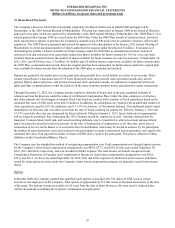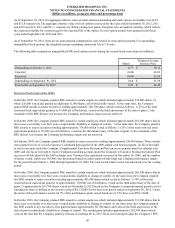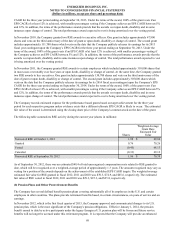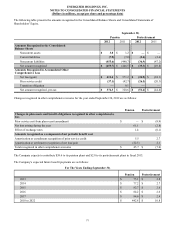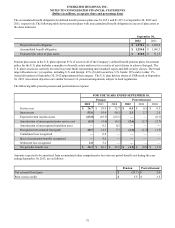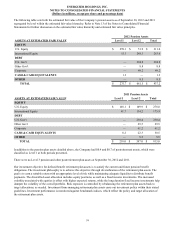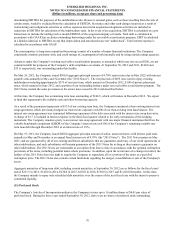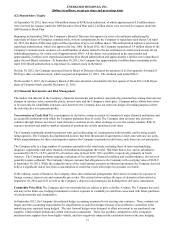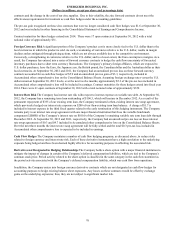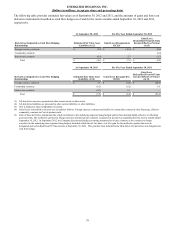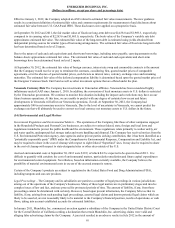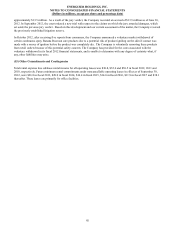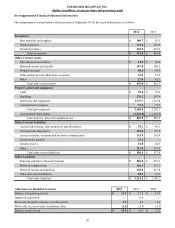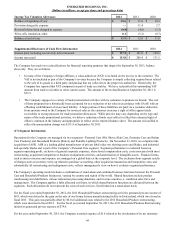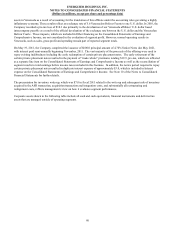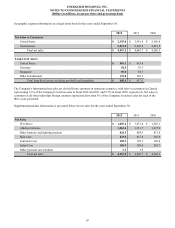Energizer 2012 Annual Report Download - page 87
Download and view the complete annual report
Please find page 87 of the 2012 Energizer annual report below. You can navigate through the pages in the report by either clicking on the pages listed below, or by using the keyword search tool below to find specific information within the annual report.
ENERGIZER HOLDINGS, INC.
(Dollars in millions, except per share and percentage data)
(12) Shareholders’ Equity
At September 30, 2012, there were 300 million shares of ENR stock authorized, of which approximately 0.8 million shares
were reserved for issuance under the 2000 Incentive Stock Plan and 2.1 million shares were reserved for issuance under the
2009 Incentive Stock Plan.
Beginning in September 2000, the Company’s Board of Directors has approved a series of resolutions authorizing the
repurchase of shares of Energizer common stock, with no commitments by the Company to repurchase such shares. On April
30, 2012, the Board of Directors approved the repurchase of up to ten million shares. This authorization replaces a prior stock
repurchase authorization, which was approved in July 2006. In fiscal 2012, the Company repurchased 5.9 million shares of the
Company's common stock, exclusive of a small number of shares related to the net settlement of certain stock awards for tax
withholding purposes, for a total cost of approximately $418. All the shares were purchased in the open market and
approximately 2 million were repurchased under the prior Board authorization and approximately 4 million were repurchased
under the new Board resolution. At September 30, 2012, the Company has approximately 6 million shares remaining on the
April 2012 Board authorization to repurchase its common stock in the future.
On July 30, 2012, the Company announced that its Board of Directors declared the payment of its first quarterly dividend of
$0.40 per share of common stock, which was paid on September 13, 2012. The dividend paid totaled $24.9.
On November 5, 2012, the Company's Board of Directors declared a dividend for the first quarter of fiscal 2013 of $0.40 per
share of Common Stock, payable December 12, 2012.
(13) Financial Instruments and Risk Management
The market risk inherent in the Company’s financial instruments and positions represents the potential loss arising from adverse
changes in currency rates, commodity prices, interest rates and the Company’s stock price. Company policy allows derivatives
to be used only for identifiable exposures and, therefore, the Company does not enter into hedges for trading purposes where
the sole objective is to generate profits.
Concentration of Credit Risk The counterparties to derivative contracts consist of a number of major financial institutions and
are generally institutions with which the Company maintains lines of credit. The Company does not enter into derivative
contracts through brokers nor does it trade derivative contracts on any other exchange or over-the-counter markets. Risk of
currency positions and mark-to-market valuation of positions are strictly monitored at all times.
The Company continually monitors positions with, and credit ratings of, counterparties both internally and by using outside
rating agencies. The Company has implemented policies that limit the amount of agreements it enters into with any one party.
While nonperformance by these counterparties exposes the Company to potential credit losses, such losses are not anticipated.
The Company sells to a large number of customers primarily in the retail trade, including those in mass merchandising,
drugstore, supermarket and other channels of distribution throughout the world. Wal-Mart Stores, Inc. and its subsidiaries
accounted for 20.3%, 19.5% and 20.1% of total net sales in fiscal 2012, 2011 and 2010, respectively, primarily in North
America. The Company performs ongoing evaluations of its customers' financial condition and creditworthiness, but does not
generally require collateral. The Company’s largest customer had obligations to the Company with a carrying value of $120.9
at September 30, 2012. While the competitiveness of the retail industry presents an inherent uncertainty, the Company does not
believe a significant risk of loss from a concentration of credit risk exists with respect to accounts receivable.
In the ordinary course of business, the Company enters into contractual arrangements (derivatives) to reduce its exposure to
foreign currency, interest rate and commodity price risks. The section below outlines the types of derivatives that existed at
September 30, 2012 and 2011 as well as the Company’s objectives and strategies for holding these derivative instruments.
Commodity Price Risk The Company uses raw materials that are subject to price volatility. At times, The Company has used,
and may in the future use, hedging instruments to reduce exposure to variability in cash flows associated with future purchases
of certain materials and commodities.
In September 2012, the Company discontinued hedge accounting treatment for its existing zinc contracts. These contracts no
longer meet the accounting requirements for classification as cash flow hedges because of an ineffective correlation to the
underlying zinc exposure being hedged. The zinc forward hedges were designed to offset movement in our purchased zinc
supplies, which include indium and certain conversion components. These two ancillary components of the Company's
purchased zinc supplies have been highly volatile, and have negatively impacted the correlation between the zinc hedging
77


